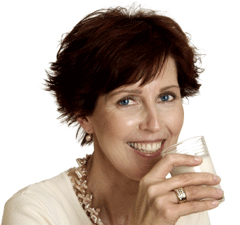 |
||||||||||||||||||||||||||||||||||||||||||||||||||||
Osteoporosis and Calcium - Preventing Menopause Bone LossOnce past the menopause the level of estrogen in your body dwindles away, and with it goes the protection oestrogen brings to your bones.
Bones constantly renew themselves, breaking down old bone in a process called resorption, and producing new bone from calcium. Without estrogen, not only does your body absorb calcium less efficiently, it breaks down bone faster than it creates new bones. The result is that your bone mass declines by about 3-5% annually after the menopause, slowing to about 1% each year by the time you're 65. Osteoporosis And Calcium: Preventing Menopause Bone LossThe mineral calcium is important for healthy heart, circulation and nervous system, but its prime function is building the skeleton, and 99% of the 1kg of calcium stored in the body is found in bones and teeth. Osteoporosis occurs when our bodies lose bone after the menopause. The bones become less dense and take on a honeycombed texture, making them weaker and much more liable to break.
There are various ways to prevent osteoporosis, including using exercises for osteoporosis, but you should also pay attention to your menopause diet and make sure you're getting enough calcium to keep your bones as healthy as possible. Recommended Daily Amount (RDA) of CalciumIn the UK, the RDA of calcium for an adult woman is 700mg, although people with osteoporosis may need more. The EU RDA of calcium is 800mg. In the US, the RDA of calcium is related to age: 1,000mg for women aged 19-50, 1,200mg for women over 50. Osteoporosis and Calcium: Foods High In CalciumA simple way to get 700-1000mg of calcium in a day is to have a pint of milk as a drink, used in cooking or served with cereal. Lower fat milks are richer in calcium than full fat milk, so you can use skimmed or semi-skimmed. As well as the milk, you should eat a 125g pot of low fat yogurt plus 60g of a hard cheese like Cheddar - low fat versions are higher in calcium. Here is a list of calcium rich foods:
If you have a poor diet, or think you might need additional calcium, ask your doctor about calcium supplements. Calcium and Vitamin DYour body absorbs more calcium from food if it also has a good supply of Vitamin D. Vitamin D and calcium keep your teeth and bones strong and help to keep osteoporosis at bay. The action of sunshine on your skin prompts your body to make Vitamin D, so make sure you get out into the sun whenever it appears, and don't keep yourself completely covered up. You can also get Vitamin D from food. Vitamin D is found in dairy products (but not low fat), eggs, fortified margarines, and oily fish such as salmon, mackerel, tuna and canned sardines. Most people get enough Vitamin D from sunlight and food. Ask your physician about Vitamin D supplements if:
Osteoporosis and HRTAlthough HRT (hormone replacement therapy) raises the level of oestrogen, which in turn helps to keep postmenopausal bones stronger and stop osteoporosis from developing, the known side effects of HRT mean that it is not now prescribed solely to treat or prevent osteoporosis. You can make sure you have enough calcium in your diet, and this may help to slow bone loss. Bisphosphonate drug treatments have been shown to increase bone mass in patients with osteoporosis, but because of side effects these should only be used for established cases, not prevention. Bisphosphonates also have side effects, and there have been suggestions, not yet proved, that using these drugs over several years can cause a risk of some unusual damage to bone, particularly in the jaw. As with all decisions on long-term medication, you should discuss carefully with your medical advisor. Osteoporosis and calcium reduction are closely linked, so be sure to choose foods high in calcium to help prevent menopause bone loss. Go from Osteoporosis and Calcium to Exercises for Osteoporosis. Go from Osteoporosis and Calcium to Beat Menopause Weight Gain. |
OUR FREE REPORT!
Get the Healthy Eating Habit and Lose Weight For Ever 
We hate spam and will never give away or sell your email address Sunlight and Vitamin D"Even weak sunscreens (SPF=8) block your body's ability to generate vitamin D by 95%. We recommend that you go outside for 5 or 10 minutes, enjoy the sun, make the Vitamin D in your arms and legs, or hands, face and arms, and then put the sunscreen on." Dr. Michael Holick, author, The UV Advantage |
|||||||||||||||||||||||||||||||||||||||||||||||||||
|
|
||||||||||||||||||||||||||||||||||||||||||||||||||||
FEEL GOOD IN YOUR BODY!Beat-menopause-weight-gain.com does not offer medical advice. Please consult your physician before making any changes to your usual lifestyle.View our Terms of Use and Privacy Policy |
||||||||||||||||||||||||||||||||||||||||||||||||||||
|
Beat Menopause Weight Gain - Feel Good in Your Body! - All Rights Reserved - Copyright© 2008-2012
| ||||||||||||||||||||||||||||||||||||||||||||||||||||



